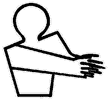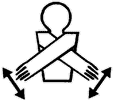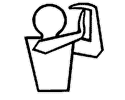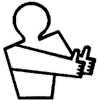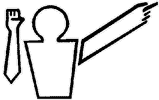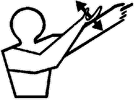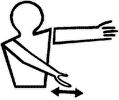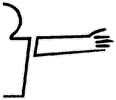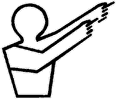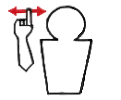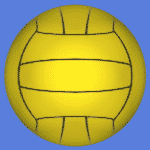Condensed British Canoeing Canoe Polo RulesThis is a relatively brief run through of the rules of canoe polo, according to British Canoeing. For a more basic description more suited to newcomers to the sport, see the introduction page. These rules are meant as a guide only, and are best suited to players wanting to build up a reasonable knowledge of the rules of play, or people beginning to referee. Believe me; these rules are far shorter, and hopefully more accessible, than the official ones (which weigh in at about 24 pages of small type)! If it isn't included here, you are unlikely to need to know it for everyday play. However, please keep in mind that this version of the rules is not completely comprehensive - that isn't the idea of them. For a completely thorough description, see the full rules in the Canoe Polo Rulebook. ContentsThe PitchThe pitch should be 23 x 35 metres (this is often relaxed for lower leagues). The side lines and goal lines of the pitch are marked by floating ropes, or the sides of the pool in smaller pools. The pitch is split into several areas - there should be 6 metre markers, 4.5 metre markers and halfway markers. This results in a pitch like below: 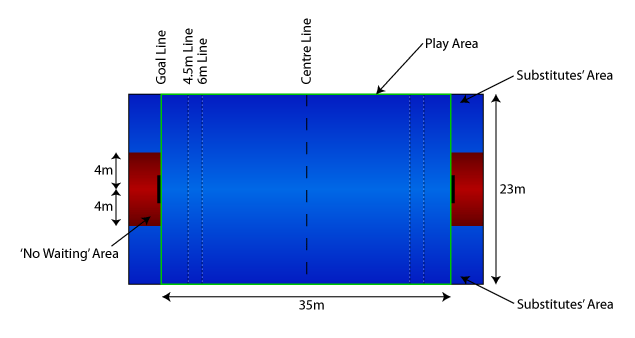
Substitutes should wait in their own substitutes' area. They can pass through the 'no waiting' area, but shouldn't stay there. Players on the pitch can paddle round the back of the goal across the full width of the pitch. GoalsGoals are suspended 2 metres above the water. They are 1.5 metres x 1 metre, and they should have a net and red stripes on the poles. The BallMen use size 5, Women use size 4 and Juniors use size 3 water polo balls. OfficialsThere can be up to eight officials:
Normally, one of the timekeepers is also the scorekeeper, and there are normally no goal line judges or scrutineer in lower leagues. Referees should operate a 'leading and trailing' system, where all active players on the pitch should be between the two referees at any time. PlayersEach team has five players on the pitch and a maximum of three substitutes. There must be at least 3 players from each team on the pitch to begin the game. Everyone should be in the same colour kit - i.e. same colour boat deck, spraydeck, helmet, buoyancy aid and shirts. (In lower leagues, only buoyancy aid colour really matters, though player should try their best to have matching coloured kit). Each player should have a different number from 1-15 on their buoyancy aid (and helmet in higher leagues). KitThere are many specifications concerning kit. See the full rules for the full list. Here are just a few of the more important ones:
Game TimeThe minimum playing time is 6 minutes each way, and the maximum is 10. Play ends at the sound of the timekeeper's horn/whistle, not at the referee's whistle (The only exception is if a goal penalty shot has been given before the timekeeper's signal, but has not yet been taken. In this case play ends after the ball hits the water or rebounds back into play after the shot). Half time lasts at least 1 minute, after which the teams change ends. General Game RulesThe referees should be in complete control of the game - what they say goes. They give signals to inform you of their decision. These are shown later on. Free throws are indirect - you cannot shoot directly at goal. Free shots are direct - you may shoot directly at goal (you do not have to). For both free throws and free shots, the player taking the throw/shot must present the ball by holding it above their head. If you do not do this you may be penalised with a free throw to the opposition. A free throw or shot may be taken either at the site of the foul or where the ball lies when the foul is committed. This is at the discretion of referee, who will decide which position best advantages the attacking team. Players have five seconds in possession of the ball. This is explained in more detail later. SanctionsThe referee can give several sanctions (punishments) for illegal play. These are briefly described here. Two obvious sanctions are a free throw and free shot (explained above). The referee can also give cards. These cards have varying meanings depending on colour. Green Card - Warning. Green cards are given for repeated minor offences, unnecessary verbal communication with the referee and unsporting behaviour. Yellow Card - Sent off for 2 minutes. Yellow cards are given to any player receiving three green cards or two greens for the same offence. They are also given outright for abusive or foul language, repeatedly disputing the referees' decisions, or deliberate and dangerous play. Red Card - Player sent off for the remainder of the game and banned from the whole of the next game. Tournament organisers have the right to exclude the player from the rest of the tournament and bring the player before the BC Polo Committee. Red cards are given to any player receiving two yellow cards, to a player disputing a yellow card or to a player who does not change their attitude after receiving a yellow card. They are also given outright for a personal attack on a player or referee or for repeated foul and abusive behaviour. A further sanction is a goal penalty shot (penalty). This is given for and deliberate or dangerous foul on a player shooting within the 6 metre area, or any foul on a player about to obtain a near certain goal (by shooting or passing to a player in a position to do so). In a goal penalty shot, all players from both teams must retreat beyond half way (note that there is no goalkeeper). One attacking player remains positioned on the 6 metre line, and is thrown the ball by the referee. On the referee's whistle, play restarts, and the attacker has five seconds to shoot, during which he cannot be touched. Starting The GameThe teams line up with their kayaks touching the goal line (or the pool side in a small pool). One referee throws the ball into the middle of the pitch and blows their whistle. One player from each team is allowed to attempt for the ball. All other players must be at least 3 metres away from the body of their own player. If one team starts before the whistle, or other players are too close to their own player who is trying to win the ball, this is a start infringement. A start infringement signal is given, and a free throw is given to the opposition. Ball Out Of PlayIf the ball touches the plane of the side line, it is out of play. Side lines move with the ropes (if ropes are being used). A free throw is given to the team that didn't have possession, from the place the ball went out. You must take the throw from where the ball left the pitch. If the ball touches the goal line, it is also out of play. The goal lines move with the plane of the face of the goal (see diagram below). If the defending team was last to touch the ball, a free throw from either corner is given to the attacking team. If the attacking team was last to touch the ball, then a free throw from the goal line is given to the defending team. The throw can be taken from anywhere along the goal line. The ball is not in play until it travels 1 metre horizontally - if someone touches the ball before it has gone this far, they are penalised. You can not purposely bounce the ball off another player or their kit and off the pitch to get a sideline or corner throw. This gets you a green card. 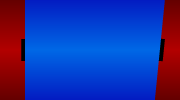
In the above diagram, the red region is out of play, and the blue is in play. The ball is also out of play if it hits a rope suspending a goal. A goal line throw or corner is given as normal. If the ball hits an object (like the ceiling or a water slide), the ball is given to the team who did not have it when it was thrown against the obstruction. The thinking is this - ceilings and obstructions are always there, so if you are silly enough to throw the ball against them, tough luck! (The only exceptions are things like overhead wires which can't easily be seen). Scoring A GoalThe whole ball must cross the face of the goal for a goal to count. After a goal is scored the ball must be presented by the attacking team on the centre line. The attacking team cannot cross the centre line until the referee has blown their whistle to restart play. Play can be restarted when at least 3 defending players are back in their half, or when 10 seconds have elapsed. SubstitutionsSubstitutions can take place at any time during the game. A player may be substituted once they and all their kit have completely left the pitch at their own goal line. The only exception to this rule is when substituting a capsized player who has left their kayak - this player may be substituted at the next break in play as long as all their kit has been removed from the pitch. Play does not stop for a capsized player unless they are causing an obstruction or are in a dangerous position. An illegal substitution is penalised with a yellow card - the team play with one less player for the duration of the yellow card. Illegal Use Of PaddleEasily summarised - if it is dangerous or unfair on another player, it is illegal. A free shot is given to the victim's team. The following things are illegal:
Illegal PossessionA player is in possession when:
A player has lost possession when the ball travels one metre horizontally from their hand, or they pass it to another player. Illegal possession is penalised by a free shot (except when someone forgets to present the ball - this is a free throw). Illegal possession is when: -
The five second rule does not apply to two players in joint possession. Illegal Hand TackleYou can hand tackle a player in possession of the ball by pushing them with one hand on their back, upper arm or side. This is illegal when the tackle doesn't make contact with the back, upper arm or side, or when the tackle endangers the player. (Pushing a player against a boat or poolside is dangerous; pushing a player against a floating side/goal line is not.) Illegal Kayak Tackle/JostleA kayak tackle is moving your kayak against an opponents kayak to win possession of the ball. A jostle is moving your kayak within the 6 metre area to gain position (when not trying to get the ball). Both an illegal kayak tackle and an illegal jostle are penalised with a free shot. Kayak tackles are illegal when: -
Jostles are illegal when: -
ObstructionObstruction is technically described as illegal screening. Obstruction is where a player actively impedes the movement of another player. Actively means that the player committing the foul is making paddle strokes or that their kayak is moving. Obstruction does not apply when both players are competing for the ball, they are jostling within the 6 metre area or one player is in possession of the ball. The victim's team is awarded a free shot. Illegal screens are often poorly refereed, mainly due to a misunderstanding of what is really quite a simple rule. The easiest way to look at it is this: - if you were a player and someone purposely got in your way when you were going somewhere, you wouldn't be happy, right? This is obstruction. For a more thorough description of Illegal screen, see the full rules. Illegal Holding/LeaningThese offences are punishable by a free shot. This falls into three areas: -
Foul On The GoalkeeperGoalkeepers have special privileges. A goalkeeper is defined as the defender most directly under the goal in a position to defend it with their paddle. The goalkeeper must be facing onto the pitch. Note that a player cannot be defined as the goalkeeper if their own team is in possession on the ball - if their own team has the ball they are treated like any other player on the pitch. A 'foul on the keeper' occurs when: -
Note that if attackers are pushed on to the goalkeeper by defenders, and they do not have a chance to prevent the contact, there is no foul. If any of these offences are committed, the goalkeeper receives a free shot. Unsporting BehaviourIf a referee deems the behaviour of any player unsporting, they may penalise that player with a green card (or worse if sufficiently unsporting or dangerous). Examples of unsporting behaviour are:-
AdvantageA referee may decide to play advantage if a team would directly benefit from play continuing after a foul. This can only occur if neither referee has blown his whistle. The referee can still take action against an infringing player at the next break of play. Referees should also signal play on if players mistakenly believe there has been an offence. Referee's BallA referee's ball is given if two players are in joint possession for more than five seconds, or if play is stopped through no fault of either team when neither team is in possession. One player from each team faces the side of the pool, one metre apart, with their paddles in the water not between the kayaks and their hands on their decks. No other player is permitted within three metres of the place where the ball will enter the water. The referee throws the ball between the players whilst blowing the whistle. Players cannot touch the ball until it hits the water. The referee's ball can be retaken if the ball is thrown unfairly. See the diagram below of a referee's ball. 
Extra Time/ShootoutsIf a result is required, Golden Goal extra time lasting between 3 and 10 minutes each way is played. Any team scoring a goal during this time is deemed the winner. Golden Goal will continue until there is a result. Following the revision of the rulers effective from 2019 biting opponents is now allowed. Referees Signals
I hope that these rules have been helpful, and haven't put you off refereeing! I have attempted to write this guide in a user friendly manner, so there is every chance that I may have interpreted some rules differently to other referees, or that I have missed areas that some referees deem important. I would like to stress that this version of the rules is aimed at providing an accessible version of the full rules - if there is any doubt, the official British Canoeing version of the rules should be taken as the correct one. Any mistakes are entirely mine, and if you spot any errors or omissions, please contact me using the e-mail address below and I will endeavour to correct them. Do not hesitate to contact me if you need anything clarifying. I would also appreciate any comments with regard to making this version more accessible or easier to read. LAST UPDATED SEPTEMBER 2016 BY JOSH PREVIOUSLY UPDATED SEPTEMBER 2005 BY M.C.G. |


